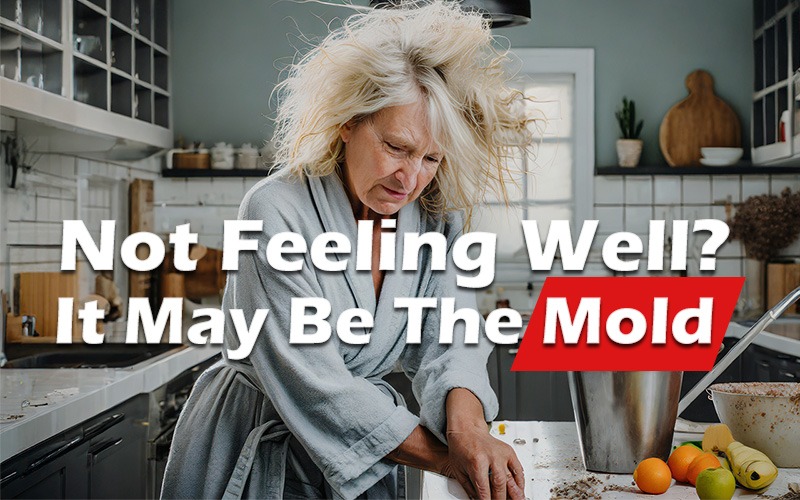Mold Toxicity: It May Be Why You’re Sick

This article aims to raise awareness about mold toxicity and its devastating harmful effects that can even lead to death.
Please continue reading if you can answer in the affirmative, for yourself or a loved one, to any of the following questions:
- Are you sick and tired of being sick and tired?
- Do you continue to struggle with illness despite adopting a healthy diet and a healthier lifestyle?
- Have you done everything you can spiritually and physically, yet you’re still sick?
You have prayed, fasted, and given up processed foods and high-sugar foods and drinks; you get as much sunshine as you can; you exercise as much as you can; you have taken this supplement and that supplement, but you’re still not well. If this sounds like you, like me, your issue may be mycotoxicosis.
What is mycotoxicosis?
Mold toxicity or mycotoxicosis is a condition caused by mycotoxins, which are toxic substances produced naturally by certain types of molds. These molds are fungal organisms that thrive in moist environments. Exposure to mycotoxins can be harmful when they are ingested, inhaled, or even absorbed through the skin. Because mycotoxins are used in some pharmaceutical medicines, they can also be consumed via antibiotics, growth promotants, and other kinds of drugs.
Mycotoxicosis is often overlooked because it has a variety of seemingly unrelated symptoms and can affect multiple systems within the body.
Most physicians have not received any training on mold toxicity or identifying it. I suffered from mold toxicity myself for years before I was diagnosed correctly.
Most physicians have not received any training on mold toxicity or identifying it. I suffered from mold toxicity myself for years before I was diagnosed correctly.
Sakinah Bellamy, Holistic Health Coach and Certified Personal Trainer, Natural Max Health
How are mycotoxins absorbed via the skin?
Mycotoxins can be inhaled or absorbed via the skin from moldy environments, such as damp buildings, farms, or factories. Unfortunately, many people have mold in their homes and inhale and absorb it daily.
According to research statistical data, up to 47% of homes in the U.S. are affected by persistent dampness and mold.
Truth About Mold website
If you suspect mold, please have the location tested. Your life, or the life of those you love, may depend on it. Mycotoxins can also be absorbed through the skin by handling something moldy, such as disposing of a piece of moldy fruit.
Mycotoxins find their way into our food?
Several hundred different mycotoxins have been identified, but the most commonly observed mycotoxins that present a concern to human health and livestock include aflatoxins, ochratoxin A, patulin, fumonisins, zearalenone, and nivalenol/deoxynivalenol. Mycotoxins appear in the food chain due to mold infection of crops both before and after harvest. Environmental factors such as temperature, humidity, and rain affect whether mold will grow on food while it is growing, being harvested, and/or stored.
The foods most susceptible to aflatoxins include peanuts, corn, tree nuts such as Brazil nuts and pistachios, dried beans, dried fruits, coffee, and some small grains such as rice. According to the U.S. Food and Drug Administration, exposure to mycotoxins can happen either directly by eating infected food or indirectly from animals fed contaminated feed from milk.
Understanding that mycotoxins are highly resistant to chemical breakdown and can survive food processing is crucial. Among these toxins, aflatoxins are the most notorious for their dangerous effects, such as increasing the risk of liver cancer, causing birth defects, and leading to kidney and immune system problems when consumed regularly. Eating food containing a large amount of aflatoxins at one time can even cause liver failure.
Mycotoxicosis causes a wide variety of adverse health effects.
Mycotoxins are incredibly harmful. The adverse health effects of mold toxicity range from acute poisoning to long-term impacts such as immune deficiency and cancer. Even the most minuscule amounts of mold toxicity can cause disease and death in humans and other animals. Many common symptoms relate back to mold, such as:
- Asthma
- Eczema
- Allergies
- Skin infections
- Chronic pain
- Fatigue
- Headaches
- Insomnia
Mold also leads to Neuroinflammation, such as:
- Brain fog
- Cognitive dysfunction
- Depression
Mold can disrupt the microbiome and suppress the immune system. Reversing the adverse effects of mold toxicity can be challenging and unpredictable. It can impact various bodily systems, and the extent of damage varies from person to person.
In this article, we focused on raising awareness about the detrimental effects of mold toxicity; we did not delve into the healing techniques. However, if you want to learn more about mold toxicity and how to heal from its effects, please watch for my next article, “Healing from Mold Toxicity.”
